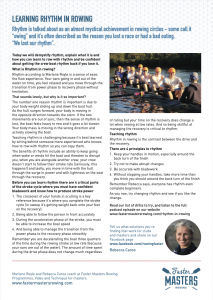Rhythm is talked about as an almost mystical achievement in rowing circles - some call it “swing” and it’s often described as the reason you lost a race or had a bad outing. “We lost our rhythm”.
Today we will demystify rhythm, explain what it is and how you can learn to row with rhythm and be confident about getting the crew boat rhythm back if you lose it.
What is Rhythm in rowing?
Rhythm according to Marlene Royle is a sense of ease, the flow experience. Your oars going in and out of the water on time, you feel relaxed and you move through the transition from power phase to recovery phase without hesitation.
That sounds lovely, but why is it so important?
The number one reason rhythm is important is due to your body weight sliding up and down the boat hull. As the hull surges forward, your body is moving in the opposite direction towards the stern. If the two movements are out of sync, then the sense of rhythm is lost, the boat feels heavy to row and it goes a lot slower. Your body mass is moving in the wrong direction and actively slowing the boat.

Teaching rhythm is challenging because it’s best learned by sitting behind someone more experienced who knows how to row with rhythm so you can copy them.
The benefits of rhythm include an ability to keep going when wake or winds hit the boat and threaten to disrupt you, when you are alongside another crew, your crew doesn’t start to follow their stroke rate (seriously, this happens!) and lastly, you move in time with the hull through the surge in power and with lightness on the seat through the recovery.
Before you can learn rhythm there are 4 critical parts of the stroke cycle where you must have confident bladework and know how to produce stroke power.
- The crossover of your hands in sculling is a key reference because it’s where you complete the stroke cycle (in sweep it’s getting weight back onto your feet on the recovery).
- Being able to follow the person in front accurately
- During the acceleration phase of the stroke, you must be able to increase the boat speed
- And being able to manage the transition from the power phase to the recovery phase smoothly
Remember you are decelerating the boat three quarters of the time during the rowing stroke at low rate (because your oars are out of the water). The amount of time spent during the drive phase does not change much regardless of rating but your time on the recovery does change a lot when rowing at low rates. And so being skillful at managing the recovery is critical to rhythm.
Teaching rhythm
Rhythm in rowing is the contrast between the drive and the recovery.
There are 4 principles to rhythm
- Keep your handles in motion, especially around the back turn of the finish
- Try not to make abrupt changes
- Be accurate with bladework
- Without stopping your handles, take more time than you think you should around the back turn of the finish
Remember Rebecca says, everyone has rhythm even complete beginners.
As you row, try changing rhythm and see if you like the change.
Drills for you to try
- Row a half pressure catch and a three quarter pressure finish - this exaggerates the acceleration through the drive and can help you create a stronger rhythm.
- Learn how to use the body swing mid-stroke. This has to be trained and can be learned with a simple sequence of 10 strokes at each of these stages:.
Body swing only (straight arms); body and arms; half slide; full slide normal rowing. Try to keep your back swinging when you move from body swing only to adding the arms. - Try to blend legs, back and arms and end the stroke with all 3 parts together. Then after you have made a strong second half of the drive phase, move smoothly to the recovery and notice the contrast. That’s rhythm.
Masters Rowing Advocates
Would you like to publish this article in your club newsletter or website?
Join our Masters Rowing Advocates mailing list and we will send you one article a month. Sign up on our Advocacy page.
You can copy the text on this page. Or download the PDF


